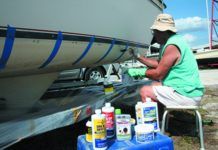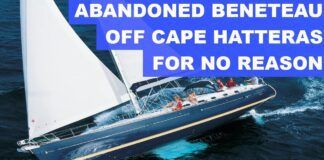Varnish Over Treatment?
I’m looking at buying a used boat – an Alerion Express – that currently has Cetol on its exterior woodwork. I greatly prefer varnish. I cannot find any back articles or other advice about my quandary. Can I overcoat the Cetol with varnish? Is it possible to remove/bleach/sand the Cetol and start over with varnish? Any suggestions?
-Chuck Eaton
Mill Valley, California
The rule once was that you could overcoat any varnish with any other varnish – if you sanded the surface to provide “tooth” for the new varnish. We’ve done it (changed brands and types of varnish) dozens of times, with not a single failure.
No more. The new chemical or doctored-up finishes may be better, but they’re not simple.
Now, about Sikkens Cetol. It is owned by Akzo Nobel, the Dutch company that claims to be the world’s largest coatings outfit. It owns, among many other things, International Paints, through whose Interlux Division (yacht finishes) Cetol is now marketed.
An Interlux technical advisor said that, unlike any varnish, Cetol is oil-based. It must be removed with a non-wax marine stripper, or sanded off. The strippers are messy and hard to work with. Sanding is long, arduous work. Getting all the Cetol off is not an easy task. We think we’d want to wipe it down several times with acetone, as is often recommended for raw teak when you want to use varnish. We might also give it a good scrubbing with detergent.
To check this all out, we’d probably do a couple of small patches somewhere inconspicuous, just to see how thorough the stripping must be to permit varnish to “take” and last. Unfortunately, it would take some time, a season or two, to check it out.
The alternative would be to sand it all (use 80-grit first, then 120), apply the varnish and see if any part of the job needs touching up. Cracks, crevices and edges would be where we’d expect trouble.
If you could remove the teak parts, you could do them at home with confidence in the off season. We’ve done this many times. Except for teak toe rails, many parts (handrails, hatches, seats, hatch frames, cockpit trim, etc.) are easier to remove than you might think.
A boat of such high quality deserves the best.
———-
Toilet Paper for Sea & Soil
I’ve consulted Practical Sailor for years, especially two years ago when I bought a trawler. I found the reviews were just as relevant for many of the systems that I needed.
I can’t find a review for toilet paper. When I winterize my boat ( Pacific Seacraft 38T Fast Trawler), which has a macerator pump, I find I have to flush-rinse the tank through the macerator to get rid of accumulated paper at the bottom of the tank and drain hose to the macerator. Without that step, I run the risk of not getting a strong enough antifreeze solution to the pump, resulting in freeze risk to the pump and fittings. I can’t help but notice that the paper does not break down as I would expect it should, so that it would be pumped out with the rest at the pump out station.
Can you please do a review that highlights the paper that will break down quickly? You have reviewed all other systems relative to holding systems, this one could finish the series.
-Bob Kunath
Hawthorn Woods, IL
We evaluated domestic versus marine toilet paper in the June 15, 1996 issue, and found that paper from SeaLand and Thetford (and a brand called Second Nature Plus, from a local environmental store) did, in fact, dissolve faster than the standard Quilted Northern that they were compared to – and they were able to pass through narrow strictures more easily.
Our testers, at the suggestion of SeaLand, put single sheets of the various papers into a jar with a small hole in the top, then filled it to 3/4 capacity with water and shook 20 times. All the marine/RV paper dissolved rapidly and passed through the hole; the Quilted Northern didn’t. Thus the marine/RV paper does represent a lesser threat to the onboard plumbing. The Quilted Northern was best in the strength test, and softest, but the others were about equal to each other in these categories, too. So take your pick based on the best prices you can find.
The article concluded: “Given our distaste for tearing into any part of the toilet and related components, the price for marine-grade tissue seems like a bargain. Remember, there are no plumbers at sea!”
Speaking of having (or not having) to tear into marine plumbing, neither the Air Head nor the SunMar composting toilet we looked at in the November 15, 2002 issue requires special TP, but the fast-degrading paper would make the compost more easily agitated, and more uniform in a shorter time, whether or not it plays a role in the composting process itself.





































